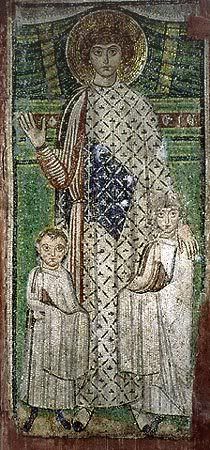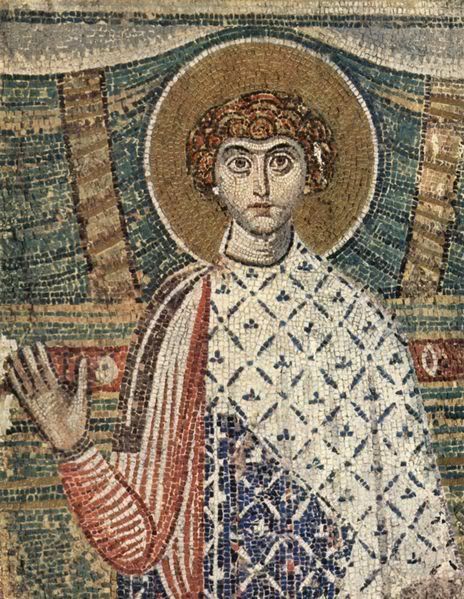---------
The spelling "Demetrius" is a romanization of the ancient Greek pronunciation; the Byzantine and Modern Greek romanization is Dimitrios, and it is this spelling which is generally used by Greeks today. The name originally comes from the Greek pre-Christian goddess Demeter which in turn means "distribution-mother". Dimitris and Dimitra remain common names among Greeks.
In Russian, he is called Димитрий Солунский ([dimitri solunski] 'Dimitri of Thessaloniki') and was a patron saint of the ruling Rurikid family from the late 11th century on. Izyaslav I of Kiev (whose Christian name was Dimitry) founded the first East Slavic monastery dedicated to this saint. The name Dimitry is in common use.
The Serbian Orthodox Church reveres St. Demetrius as Mitar, having a feast of Mitrovdan on 8 November, which is a public holiday in the Republika Srpska part of Bosnia and Herzegovina.
He is known in Lebanon as Mar Dimitri or Mitri for short, which is a common name among Christian Lebanese.
He is known in the Coptic Church as "St. Demetrius of Thessalonica". He is venerated in the Coptic Church on 8 November.
---------
The earliest written accounts of his life were compiled in the 9th century, although there are earlier images of him, and accounts from the 7th century of his miracles. The biographies have Demetrius as a young man of senatorial family who was run through with spears in around 306 in Thessaloniki, during the Christian persecutions of the emperor Diocletian or Galerius, which matches his depiction in the 7th century mosaics.
---------
The origins of his veneration are obscure; the first evidence of his systematic veneration comes about 150 years after his martyrdom. Therefore some modern scholars question the historicity of the man.[1]
One theory is that his cult was transferred from Sirmium when Thessaloniki replaced it as the main military base in the area in 441/442. His very large church in Thessaloniki, the Hagios Demetrios, dates from the mid-5th century, so he clearly had a large cult by then. Thessaloniki remained a centre of his cult, and he is the patron saint of the city.
After the growth of his cult, Thessaloniki suffered repeated attacks and sieges from the Slavic peoples who moved into the Balkans, and Demetrius was credited with many miraculous interventions to defend the city. Hence later traditions about Demetrius regard him as a soldier in the Roman army, and he came to be regarded as an important military martyr. Unsurprisingly, he was extremely popular in the Middle Ages, and along with Saint George, was the patron of the Crusades.
For four centuries after his death, St. Demetrius had no physical relics, and in their place an unusual empty shrine called the "ciborium" was built inside Hagios Demetrios. What were claimed to be his remains subsequently appeared in Thessaloniki, but even the local archbishop (John of Thessaloniki, 7th century) was publicly dismissive of their authenticity.[2] These are now also kept in Hagios Demetrios. According to legend, these relics were ascertained to be genuine after they started emitting a perfumed scent of myrrh. This gave the saint the epithet "Myrovlētēs" (Greek: Μυροβλήτης, the Scent-Giver). This has not been attested in modern times.
In the Russian Orthodox Church, the Saturday before the Feast of St. Demetrius is a memorial day commemorating the soldiers who fell in the Battle of Kulikovo (1380), under the leadership of St. Demetrius of the Don. This day is known as Demetrius Saturday.
---------
St. Demetrius was initially depicted in icons and mosaics as a young man in patterned robes with the distinctive tablion of the senatorial class across his chest. Miraculous military interventions were attributed to him during several attacks on Thessaloniki, and he gradually became thought of as a soldier: a Constantinopolitan ivory of the late 10th century shows him as an infantry soldier (Metropolitan Museum of Art).[1] But an icon of the late 11th century in Sinai shows him as before, still a civilian.
Another Sinai icon, of the Crusader period and painted by a French artist working in the Holy Land in the second half of the 12th century, shows what then became the most common depiction. Demetrius, bearded, rather older, and on a dark horse, rides together with St George, unbearded and on a white horse. Both are dressed as cavalrymen. Also, while St. George is often shown spearing a dragon, St. Demetrius is depicted spearing the gladiator Lyaeos, who according to legend was responsible for killing many Christians. In traditional hagiography, Demetrius did not directly kill Lyaeos, but rather through his prayers the gladiator was defeated.
A modern Greek iconographic convention depicts Demetrius with the White Tower of Thessaloniki in the background. The anachronistic White Tower acts as a symbolic depiction of the city of Thessaloniki, despite having been built in the 16th century, centuries after his life, and the exact architecture of the older tower that stood at the same site in earlier times is unknown.
---------
This is the most accurate information i could find on him, i cant really translate ancient greek too well, so i didnt try and decipher what lays downstairs in the book cases.
Here are a few photos though!

close up
